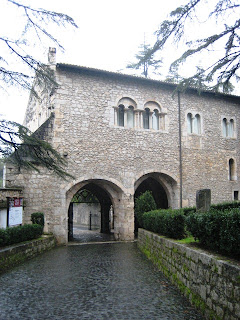Saturday and Sunday this weekend were filled with prayers, touring, and learning about St. Benedict and St. Scholastica. We visited Montecassino and Casemari on Saturday, and the Holy Grotto and St. Scholastica Abbey in Subiaco. I have many pictures. I am going to download them tonight, but I will return to write the captions for each one tomorrow.
 |
| Montecassino on the summit in the center. Not a very clear picture but its there. There has been a monastery here since 529 AD. It has been destroyed several times; in 577 by the invading Lombards, in 883 by the Saracens, in 1349 by an earthquake, and in WW II by Allied bombs. See the following photo. |
 |
| An airial view of the Montecassino as it exists today. The monastery was completely rebuilt including the magnificent abbey church. This is a picture of the monastery reconstructed according to original plans after the destruction in 1944. |
 |
| Montecassino Monastery after the February 15, 1944 bombing by the Allied forces in WW II. The Allies had false information that the Germans were ocupying the monastery. 200 Monks and civilians were taking shelter in the monsatery assuming they would be safe. They all lost their lives during the 3-hours of constant bombing. In this massive destruction, the only part that survived was the mortal remains of Sts. Benedict and Scholastica. There was a single unexploded bomb that was found embedded in the marble steps inches away away from the grave. |
 |
| The Montecassino cloister. In the center is the opening for the cistern which is constructed under the cloister. The floor of the cloister slopes outward towards the pillars where there are drains to collect the rainwater. This was the only water supply for the abbey. The cistern is about 20 feet deep. |
 |
| The facade of the abbey church |
 |
| In the sacristy preparing for Mass. |
 |
| The ceiling in the sacristy |
 |
| The floor in the sacristy. There are over 60 colors and varieties of marble throughout the church. |
 |
| One of the cabinets in the sacristy. There are 12 statues and panels like this one. |
 |
| Signing the register before Mass. Every priest who celebrated Mass in this abbey for the past 600 years is recorded here. Its signed: Rev. Richard E. Degagne, St. John Neumann, Diocese of Fall River Mass. |
 |
| Father Paul Martin of New Zealand presiding at our Mass in the crypt chapel. St. Benedict and his sister, St. Scholastica are buried here. |
 |
| Our group after Mass. |
 |
| All the ceilings are mosaics; all the walls are granite carved in relief, and the floors are marble parquet. |
 |
| One of the side altars in the crypt. |
 |
| The main altar of the upper church. The church was able to be restored because there were many photographs showing the interior and the details of the decorations. The church was reconsecrated by Pope Paul VI on October 24, 1964. At that time, he declared St. Benedict to the be the Primary Patron Saint of all of Europe. |
 |
| The organ behind the main altar |
 |
| The Blessed Sacrament Altar |
 |
| The presiders chair. The abbot is also the bishop of the Diocese of Cassino |
 |
| The pews in the choir |
 |
| The burial place of Sts. Benedict and Scholastica. |
A century later, a group of Benedictines who thought that the Montecassino community were no longer living in the spirit of Benedict, decided to split and form a separate community called the Cistercians. You may recall the posting of the visit to the Cistercian Monastere de Thoronet on February 26. The monastery at Casemari was the first Cistercian monastery to be formed. Here are the pictures of that abbey.
 |
| The abbey church of Casemari. Unlike Montecasino which has a baroque facade added later, this abbey preserves the medeival facade giving it a greater simplicity in keeping with the spirituality of the Cistercians. |
 |
| The gothic interior of the abey church with its simplicity and lack of decoration. There is still a bit more detail than Thoronet which you can see on the February 26 posting. |
 |
| Another angle of the nave. Note the windows. They are not glass. They are alabaster; a thinly sliced type of marble that is very translucent. There is a detailed photo following. |
 |
| As alabaster window. The patterns are the natural patterns of the stone. These windows are nearly 1000 years old. |
 |
| Another picture of the alabaster windows, this one taken without flash. It shows more clearly the beautiful patterns of the stone. |
 |
| These choir pews are a later addition in the 17th century when baroque influences were added to the church. There is a baroque marble baldachino over the altar. The church was much too dark to get a clear picture. We were all agreed that it simply does not fit in the church. The only value in having a good picture of it would be to illustrate that at times a combination of styles just does not work. |
 |
The gate house of Casemari. The upper portion of the gate house was a 16th century addition. It was a residence of the administrator of the monastery. Sometimes, an administrator would be appointed to the abbey if the abbey territory had been lost to another government or noble family who won it in war. A cleric or even a lay person appointed to represent the interests of the nobleman or government lived apart from the monks but would be the ruler of the abbey.
|
Tomorrow we will visit the monasteries of the Holy Grotto and St. Scholastica.


























